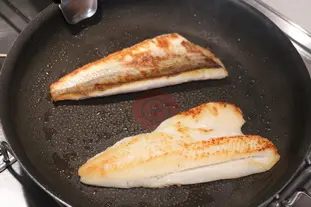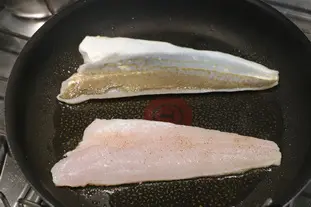This site uses only a few technical cookies necessary for its operation. By continuing to browse, you accept their use.
To find out more...
To find out more...
The skin side of the fish first?

When it comes to cooking fresh fish, if it's filleted with its skin on and you're planning to pan-fry it in a little olive oil, for example, you might ask yourself the following question: Which side, skin or flesh, should come into contact with the pan first?
26 K 4.4/5 (19 reviews)
Keywords for this post:FishCookingSkinFleshTipLast modified on: February 13th 2021
The skin side of the fish first?
You will probably read here or there that it is always the skin side first, we always grill longer on that side, and first, because we often want to get a nice crispness, when the skin is eaten, for whiting or sea bass for example.
This is often true, and for thick filleted fish, salmon for example, it allows to remove it quite easily once its side is cooked.
But for some thin fish, it is not always interesting: the skin stretches brutally in contact with the pan, and deforms the fillet into a bow.
This is very pronounced for red mullet, for example. It doesn't change the taste of the fish, but it makes it look a little less appetizing.
But if you start with the flesh side, the skin will not reach the desired crispness, or else with the risk that the fish is a bit overcooked.
You will notice at this point that even if the skin is still tense, the flesh, just seized, is much better, and your fillet does not deform, or less.
If necessary (fillet a little thick) finish with a third, short turn, on the flesh side, to finish browning well.
Another possible solution is to scarify the skin side over a few millimetres deep with a small, very sharp knife to prevent it from shrinking.
To sum up: For fine fish fillets whose skin is to be eaten, first cook the flesh side for 30 seconds, then cook the skin side normally.

This is often true, and for thick filleted fish, salmon for example, it allows to remove it quite easily once its side is cooked.

But for some thin fish, it is not always interesting: the skin stretches brutally in contact with the pan, and deforms the fillet into a bow.
This is very pronounced for red mullet, for example. It doesn't change the taste of the fish, but it makes it look a little less appetizing.
But if you start with the flesh side, the skin will not reach the desired crispness, or else with the risk that the fish is a bit overcooked.
What to do?
Try to proceed in 2 times at least: Frying pan quite hot, put your fillet on the flesh side first, let cook 30 seconds, just to seize, turn over (skin side down this time), and cook the necessary time.You will notice at this point that even if the skin is still tense, the flesh, just seized, is much better, and your fillet does not deform, or less.

If necessary (fillet a little thick) finish with a third, short turn, on the flesh side, to finish browning well.
Another possible solution is to scarify the skin side over a few millimetres deep with a small, very sharp knife to prevent it from shrinking.
To sum up: For fine fish fillets whose skin is to be eaten, first cook the flesh side for 30 seconds, then cook the skin side normally.
Lasts posts
Butter vs. grease
We often read in a recipe where a pastry is put into a mould that, just before pouring, the mould should be buttered or greased. But what's the difference between these 2 terms?December 1st 20251,4745
Getting out of the fridge early
Very often when you're cooking, you need to take food or preparations out of the fridge, to use them in the recipe in progress. There's nothing tricky about this: you just take them out of the fridge and use them, usually immediately, in the recipe. But is this really a good method?November 24th 20251,2835
Who's making the croissants?
When you look at a bakery from the outside, you naturally think that in the bakery, the bakers make the bread, and in the laboratory, the pastry chefs make the cakes. It's very often like that, with each of these professions having quite different ways of working, but sometimes there's also one...November 23th 20251,176
Oven height
When we put a dish or cake in the oven, we naturally tend to put it on the middle shelf, and that's what we usually do. But in some cases, this position and height can be a little tricky, so let's find out why.October 8th 20253,3255
The importance of sieving
In recipes that use a fine powder (flour, powdered sugar, etc.), you'll often see the advice to sift before using it. To sift is to pass the powder in question through a sieve (a very fine strainer) before incorporating it into your recipe. It's often advice, but is it really useful?September 3rd 20257,9383
Other pages you may also like
The return of the "Norman hole"
You maybe know the "trou normand", this old gastronomic custom typically French which consists in taking a (small) glass of calvados, generally between the last course and the dessert? It's something that seems a bit anachronistic nowadays, having a glass of an alcohol of more than 60° in the...December 18th 202115 K4.8
What can I use for blind baking a pastry case?
When it comes to home-made desserts, tarts are always popular. They can be divided into two basic types: those cooked with their filling, such as an apricot and almond cream tart, and those where the filling is added after baking the pastry case, such as a strawberry tart or chocolate tart. For...May 2nd 2017112 K4.5
The 3 kinds of meringue
Meringue – what could be simpler? Just beaten egg whites with sugar added. This makes a fairly stiff mixture which can then be cooked in a cool oven to create those lovely, light confections. But in the world of professional patisserie, meringue comes in three different kinds. Even if the...June 14th 201365 K4.5
Candied fruits: don't get ripped off
Do you like candied fruit? You might like to nibble a handful or add it to a recipe, like a classic fruit cake or delicious Italian specialities like panettone or sicilian epiphany pie.June 21th 201768 K 24.2
Is it really necessary to cream egg yolks?
Let’s try and answer a question that crops up in cookery and patisserie, even if it verges on the existential: do the egg yolks in a custard recipe really need to be beaten until pale, or not?February 28th 201844 K4.3
Post a comment or question
Follow this page
If you are interested in this page, you can "follow" it, by entering your email address here. You will then receive a notification immediately each time the page is modified or a new comment is added. Please note that you will need to confirm this following.
Note: We'll never share your e-mail address with anyone else.
Alternatively: you can subscribe to the mailing list of cooling-ez.com , you will receive a e-mail for each new recipe published on the site.









